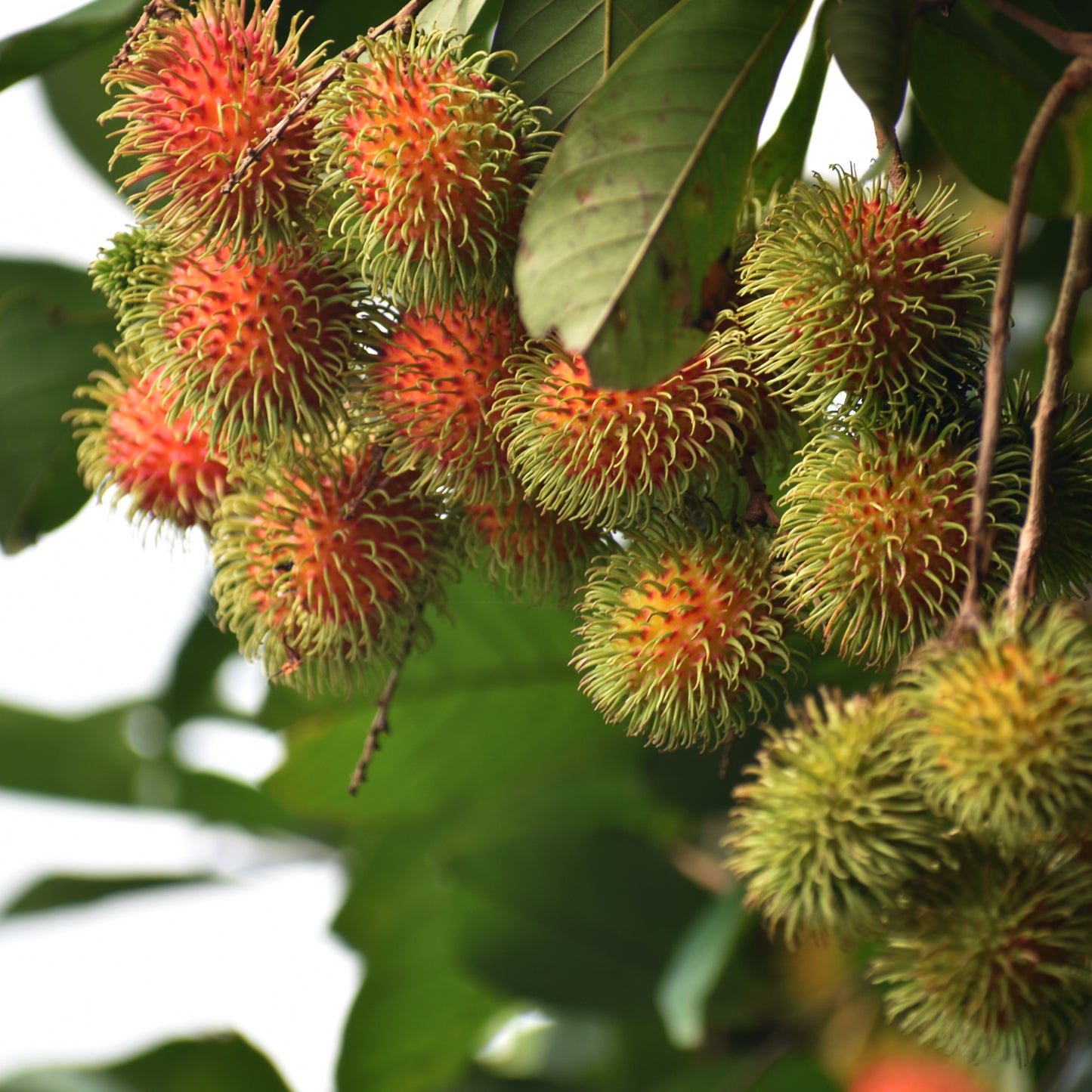Love it? Add to your wishlist
Your favorites, all in one place. Shop quickly and easily with the wishlist feature!
[message]
[title]
[message]

Veliyath Gardens
Couldn't load pickup availability
School Boy Rambutan (Anak Sekola): A Profusely Fruiting Tropical Marvel from Malaysia
Among the lesser-known yet treasured cultivars of tropical fruits, the School Boy Rambutan, also called Anak Sekola in local Malaysian dialect, holds a unique position in the fruit world. This small-sized but profusely yielding variety is a delight for tropical gardeners and fruit lovers alike. With a sweet and juicy taste, attractive dual-tone appearance, and significant health and environmental benefits, the School Boy Rambutan fruit plant is an exceptional addition to any fruit garden. At Veliyath Gardens, we take pride in making this rare and rewarding plant accessible to the discerning gardener.
Common Name: School Boy Rambutan
Local Name: Anak Sekola (Malay origin)
Botanical Name: Nephelium lappaceum
Family: Sapindaceae
Countries of Prominence: Malaysia (especially Sarawak), Indonesia, Thailand
The School Boy variety is a cherished cultivar of Nephelium lappaceum, a close botanical cousin of lychee and longan. Its name is inspired by the school-age children of Sarawak who frequently enjoy this fruit as a snack. The name 'Anak Sekola' literally translates to ‘school child’ in Malay, reflecting its popularity among younger generations.
The rind of the fruit turns a deep crimson red upon ripening.
The spines or “hairs” stay bright green even after the rind matures, creating a visually striking contrast.
The fruit size is slightly smaller than other rambutan varieties, but this is compensated by its dense cluster-bearing habit.
The taste is exceptionally sweet, with a Brix level around 21, indicating high natural sugar content.
The translucent white pulp is juicy, smooth, and lightly aromatic, offering a refreshing and pleasing bite.
This fruit is a tropical indulgence with a subtle tang that rounds off its sweetness. It makes for a delightful table fruit and an exquisite component in tropical salads and desserts.
Adding School Boy Rambutan to your diet offers multiple wellness benefits:
Rich in Vitamin C: Strengthens immune function and promotes collagen production for healthy skin.
Iron Content: Aids in oxygen transport and supports energy levels.
Dietary Fiber: Improves digestion, reduces constipation, and aids in weight management.
Antioxidant Properties: Supports cellular repair and reduces inflammation.
Low-Calorie Fruit: Ideal for healthy snacking without compromising on taste.
Traditional Southeast Asian medicine has also used rambutan peels and seeds in remedies for fever, diabetes, and skin infections, though clinical validation is ongoing.
School Boy Rambutan is more than just a snack—it’s a versatile fruit in the kitchen:
Fresh Consumption: Best enjoyed raw, chilled, or freshly peeled.
Fruit Salads: Adds texture, sweetness, and visual appeal.
Desserts: Complements jellies, puddings, and tropical fruit sorbets.
Beverages: Blends beautifully into smoothies, coolers, or infused water.
For daily use, keeping peeled rambutans refrigerated in an airtight container ensures freshness for 2–3 days.
The School Boy Rambutan tree is well-suited to tropical and sub-tropical climates. Though it requires some care, it rewards patient growers with bountiful harvests.
Tree Size: Medium to large, with a dense, rounded canopy.
Fruiting Age: Begins bearing in 4–6 years.
Soil Needs: Well-draining loamy soil enriched with organic matter.
Watering: Regular but not waterlogged; prefers moist conditions.
Sunlight: Full sun exposure ensures best growth and fruiting.
Pollination: Flowers are insect-pollinated, often requiring cross-pollination for better fruit set.
Regular pruning, seasonal mulching, and balanced fertilization improve flowering and fruit yield.
The fruit has a shelf life of about 3–4 days after harvest at room temperature. To extend its freshness:
Store unpeeled fruit in the refrigerator in breathable packaging.
Avoid moisture accumulation to prevent fungal growth.
For long-term use, pulp can be frozen and used in beverages or desserts.
In Sarawak and other parts of Malaysia, the School Boy Rambutan is celebrated during the fruiting season with local festivals and family gatherings. It is commonly sold near schools and markets, evoking nostalgia for generations of Malaysians. The fruit holds a place in local customs, where its sharing is associated with generosity and hospitality.
A rare variety not commonly found outside Malaysia.
High sweetness level and appealing look—an instant attraction in any garden.
Excellent yield, making it a reliable fruiter for small orchards and home gardens.
Enriches biodiversity and supports local pollinators.
Health-packed fruit with daily lifestyle benefits.
The School Boy Rambutan (Nephelium lappaceum) is more than a tropical delicacy—it is a delightful expression of culture, nature, and nourishment. Its sweet flavor, visual charm, and historical significance make it a meaningful addition to your garden or orchard.
At Veliyath Gardens, we are proud to introduce this rare rambutan cultivar to Indian soil. Whether you’re an exotic fruit enthusiast, a wellness-conscious gardener, or someone seeking a fruitful addition to your green space, the School Boy Rambutan is a choice you won’t regret.
Let this plant become a living story in your garden—bearing not just fruit, but memories and joy for seasons to come.
Soil Needs: Well-draining loamy soil enriched with organic matter.
Watering: Regular but not waterlogged; prefers moist conditions.
Sunlight: Full sun exposure ensures best growth and fruiting.
Rich in Vitamin C: Strengthens immune function and promotes collagen production for healthy skin.
Iron Content: Aids in oxygen transport and supports energy levels.
Dietary Fiber: Improves digestion, reduces constipation, and aids in weight management.
Antioxidant Properties: Supports cellular repair and reduces inflammation.
High sweetness level and appealing look—an instant attraction in any garden.
Excellent yield, making it a reliable fruiter for small orchards and home gardens.
Enriches biodiversity and supports local pollinators.


